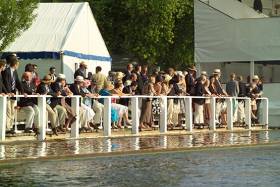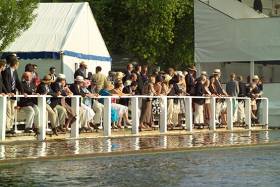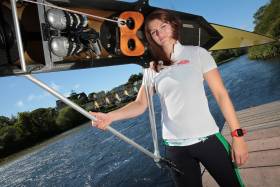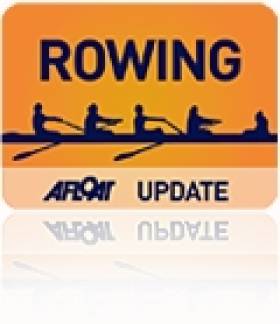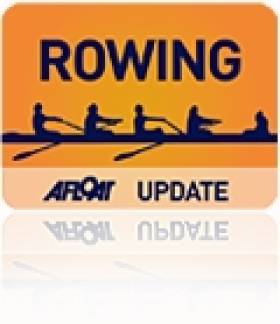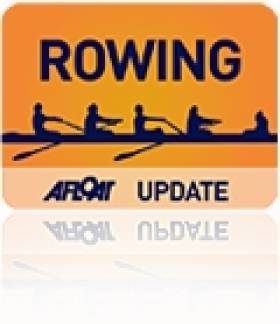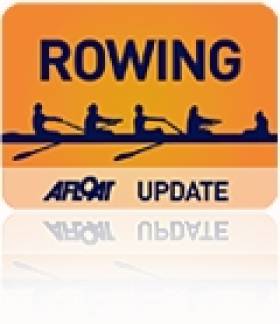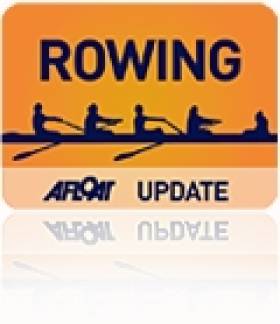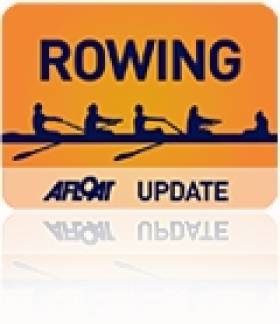Displaying items by tag: Henley
One of the great days for Irish club and university rowing will be marked at Henley Royal Regatta this year. The Henley stewards have asked the Trinity eight which won the Ladies’ Plate in 1977 to mark the fortieth anniversary with a formal row over.
Trinity had last won the Ladies’ Plate Challenge Cup over a century before, in 1875. The 1977 crew beat Pembroke College, Cambridge in the final by three and one third lengths in a time of six minutes 53 seconds.
That year the crew also won the Gannon Cup and the Universities’ Championships and represented Irish Universities at an invitational event in Egypt.
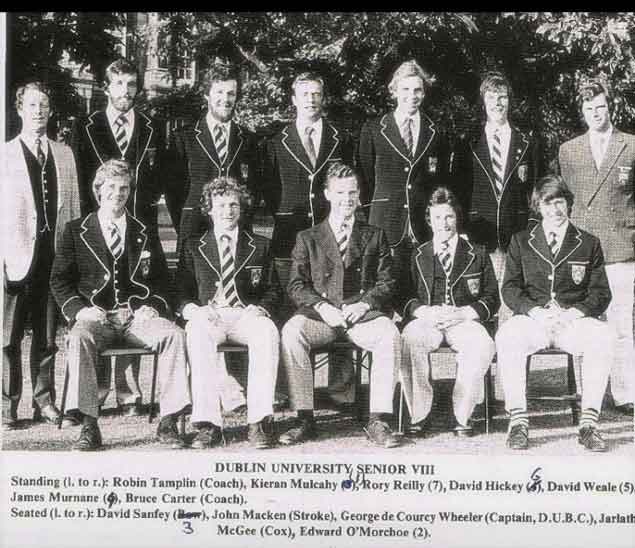
The Trinity senior coach of 1977, Robin Tamplin, sadly died this year and the crew will be rowing in a boat named in his memory. Tamplin, a former captain and president of Dublin University Boat Club, rowed for Ireland at the London Olympics at Henley in 1948.
In 2015, Sean Drea rowed over at Henley. The Neptune man had won the Diamond Sculls in 1973, 1974 and 1975.
 The 1977 Dublin University Boat Club crew
The 1977 Dublin University Boat Club crew
The Ladies’ Plate is the top eights’ event at Henley for club and university crews below The Grand Challenge Cup, at which heavyweight international crews compete.
Henley Royal Regatta is the most famous rowing regatta. Founded in 1839, it continues to draw crowds as a social event, while top rowers from around the world take part.
The regatta runs from June 28th to July 2nd this year.
Irish Hopes Extinguished as Dukarska Exits Henley
#Rowing: Ireland’s last crew at Henley Royal Regatta exited this morning. Monika Dukarska was well beaten by Lisa Scheenaard of the Netherlands in the Princess Royal for women’s single scullers. Scheenaard, on the Berkshire station, took a little time to establish a lead, but not long after the Island she had taken a half-length lead and she had a considerable clearwater advantage by the one-mile mark.
Henley Royal Regatta, Day Three (Selected Results; Irish interest):
Princess Royal (Women’s Single Sculls; Open): L Scheenaard bt M Dukarska easily; 9:17.
Prince Albert (Fours, coxed; Student): Algemene Utrechtse Studenten Roeivereniging Orca, Holland bt Trinity (M Corcoran, P Moreau, L Hawkes, M Kelly; cox C Flynn) 2¾ l; 7:40.
Neale and Jacob Battle Hard at Henley
#Rowing: The Old Collegians crew of Dave Neale and Sean Jacob lost out to Christiania Roklub of Norway in the Double Sculls at Henley Royal Regatta today. The Norwegians led from the start. They had carved out a one and three-quarter length lead by Fawley, and while the Irish crew kept them honest, they could not reel them in.
Henley Royal Regatta, Day Two (Selected Results, Irish interest)
Double Sculls (Open): K Lorentzen and S Vinje bt D Neale and S Jacob 2¾ l; 7:53.
Jacob and Neale and Dukarska Qualify at Henley
#Rowing: Dave Neale and Sean Jacob in the Double Sculls and Monika Dukarska in the Princess Royal for single scullers came through the qualifiers at Henley Royal Regatta today. Both are open events. Lady Elizabeth also made it through in the Wyfold for club fours. Trinity’s second crew, who rowed into a powerful headwind, fell just outside the qualifiers in the Prince Albert for student coxed fours.
Henley Royal Regatta – Qualifying Races (Irish interest)
Qualifiers: Princess Royal (Single Sculls; Women; Open): M Dukarska.
The Double Sculls Cup (Men; Open): D Neale and S Jacob.
Wyfold (Fours; Club): Lady Elizabeth BC
Non Qualifier: Prince Albert (Fours, coxed; Student): Trinity College, Dublin B
Trinity Exit Henley With Defeat by Cornell University
#ROWING: Trinity bowed out of the Temple Cup for student eights at Henley Royal Regatta, losing by two-thirds of a length to Cornell University of the United States. Cornell, who had a close call against Oxford Brookes B in the first round, got off to a good start and took the lead. The heavier Trinity crew were able to limit that lead to about three-quarters of a length, but could not draw level, and encountered problems with their steering. Cornell covered a late push to win.
Henley Royal Regatta, Day Two (Irish interest)
Temple Cup (Eights, Student): Cornell University, United States bt Trinity 2/3 l 6 mins 39 sec.
Princess Elizabeth (Eights, Schoolboy): Gonzaga College High School, United States bt Portora Royal School ½ l, 6:38
Narrow Loss for Gallant Portora at Henley
#ROWING: Portora Royal School lost to Gonzaga College High School by half a length in the fastest race so far in the Princess Elizabeth at Henley Royal Regatta. The Enniskillen crew gave a remarkable display, refusing to let the bigger American crew extend their early lead to clear water. The crews overlapped down the course, with Portora mounting repeated pushes. Gonzaga finished well under pressure and won in a time of six minutes 38 seconds.
Henley Royal Regatta, Day Two (Irish interest)
Princess Elizabeth (Eights, Schoolboy): Gonzaga College High School, United States bt Portora Royal School ½ l, 6:38
#ROWING: Portora Royal School brought Ireland’s winning total to two on the first day of Henley Royal Regatta. The crew from Enniskillen got off to a good start against King’s College School from Wimbledon in the Princess Elizabeth for schoolboy eights and stretched their lead to one length. But the Wimbledon boys would not give up. They ate into the lead coming up to the line and lost by just two thirds of a length.
Trinity had earlier won in the first round of the Temple Cup for student eights.
Henley Royal Regatta, Day One (Irish interest)
Temple Cup (Eights, Student): Trinity bt Pembroke and Caius Colleges, Cambridge 3¼ l, 6min 49 seconds
Princess Elizabeth (Eights, Schoolboy): Portora Royal School bt King’s College School, Wimbledon 2/3 l, 7:04
Wyfolds (Fours, Club): Nottingham RC ‘A’ bt Lady Elizabeth BC 2½ l, 7:39
Trinity Eight Ease Into Second Round at Henley
#Rowing: Trinity had a convincing win in the first round of the Temple Cup for student eights at Henley Royal Regatta today. The Dublin crew started well and powered away from the lighter crew from two colleges in Cambridge, Pembroke and Caius. Trinity were in command down the course into a headwind and came under no pressure. They won by three and one quarter lengths.
Henley Royal Regatta, Day One (Irish interest)
Temple Cup (Eights, Student): Trinity bt Pembroke and Caius Colleges, Cambridge 3 1/4 l, 6 mins 49 secs
Wyfold Cup (Fours, Club): Nottingham RC 'A' bt Lady Elizabeth BC 2 1/2 l, 7:39
Portora Royal School Speed Into Main Draw at Henley
#ROWING: Portora Royal School from Enniskillen joined Trinity and Lady Elizabeth in the main draw of Henley Royal Regatta tonight. The schoolboy eight set a fine time to make it through the qualifiers of the Princess Elizabeth. UCC and Belfast Rowing Club could not make it through in their qualifiers. Trinity, in the Temple Cup, and Lady Elizabeth, in the Wyfolds, are already in the draw.
Henley Royal Regatta, Qualification Races (Irish interest)
Princess Elizabeth (Schoolboy Eight): Portora Royal School qualified
Wyfold (Four, Club): Belfast RC 7 mins 41.3, did not qualify
Prince Albert (Coxed Four, Student): UCC 7:36, did not qualify
#Rowing: UCC’s young crew did not make it through to the main draw at Henley Royal Regatta. In the qualification races tonight they finished 12th of the 25 non-qualifiers for the Prince Albert for student coxed fours, setting a time of seven minutes and exactly 36 seconds. The Belfast Rowing Club crew which had hoped to make it through in the Wyfold for club fours also lost out. Separate to the qualifiers, Alan Campbell was listed as withdrawing from the draw from the Diamond Sculls.
Henley Royal Regatta, Qualification Races (Irish interest)
Wyfold (Four, Club): Belfast RC 7 mins 41.3, did not qualify
Prince Albert (Coxed Four, Student): UCC 7:36, did not qualify



























